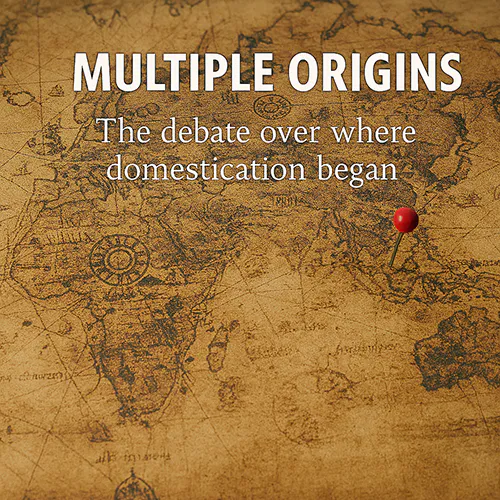
The story of dog domestication is one of the most intriguing chapters in the shared history of humans and animals. For decades, researchers have tried to pinpoint where the first wolves began their transformation into dogs. The question seems simple, yet the evidence points in several directions. Some studies suggest a single origin, while others argue for multiple domestication events in different parts of the world.
Early theories placed the birthplace of domestication in East Asia, based on genetic studies that found high diversity in dog populations there. The logic was that the region with the greatest genetic variation was likely to be the oldest centre of domestication. However, later research challenged this view, showing that European dogs also carry ancient lineages. Archaeological finds in Europe, such as dog-like remains from over 14,000 years ago, suggest that domestication may have occurred there independently.
Adding to the complexity, some genetic studies have proposed that dogs may have been domesticated twice, once in Asia and once in Europe, with the two populations later mixing. This theory is supported by the discovery of ancient dog remains in both regions that do not appear to share a single common ancestor. If true, it would mean that humans in different parts of the world formed similar relationships with wolves at roughly the same time, leading to parallel domestication events.
The archaeological record offers important clues but also raises questions. In Siberia, remains of dog-like animals dating back more than 15,000 years show signs of human association. In the Near East, evidence of early, evidence of early dogs appears alongside the rise of settled communities. These finds suggest that domestication was was not tied to a single culture or environment. Instead, it may have been a process that emerged wherever humans and wolves lived in close contact.
Genetics has transformed the debate, but it has not settled it. Advances in ancient DNA analysis have allowed scientists to compare the genomes of modern dogs with those of ancient specimens. These studies reveal a complex picture of interbreeding between early dogs and local wolf populations. Such mixing could blur the genetic signals of where domestication began, making it harder to trace a single point of origin.
The idea of multiple origins fits with what is known about human history during the late Pleistocene. People were spread across vast areas, living in small groups and adapting to different environments. Wolves were equally widespread, and their behaviour made them well suited to forming bonds with humans. In different regions, similar pressures and opportunities could have led to domestication without direct contact between the groups involved.
Some researchers caution that the concept of a single origin may be too simplistic. Domestication is not a single event but a process that can take many generations. It involves changes in behaviour, appearance and genetics, shaped by both natural and human selection. In some areas, wolves may have begun the path toward domestication but never completed it, while in others the process may have advanced more quickly.
The debate is not just academic. Understanding where and how domestication began can shed light on the nature of human-animal relationships and the adaptability of both species. It can also help explain the remarkable diversity of dogs today, from their physical forms to their behavioural traits. If dogs have multiple origins, it could mean that some of their differences are rooted in distinct domestication histories.
Resolving the question will require more evidence from both archaeology and genetics. Ancient remains are rare and often fragmentary, but each new find has the potential to shift our understanding. Improved techniques for extracting and analysing DNA from old bones may reveal patterns that are currently hidden currently. Collaboration between geneticists, archaeologists and historians will be essential to piece together the full story.
For now, the most likely answer is that domestication was a complex, regionally varied process. Whether it began in one place or several, it was shaped by the needs and choices of humans and the adaptability of wolves. The result was the creation of a new species that would become humanity’s oldest and closest companion.
The debate over multiple origins reminds us that history is rarely straightforward. The bond between humans and dogs may have been forged in more than one place, across different landscapes and cultures. What unites these stories is the shared outcome: a partnership that has endured for thousands of years and continues to shape both species today.
